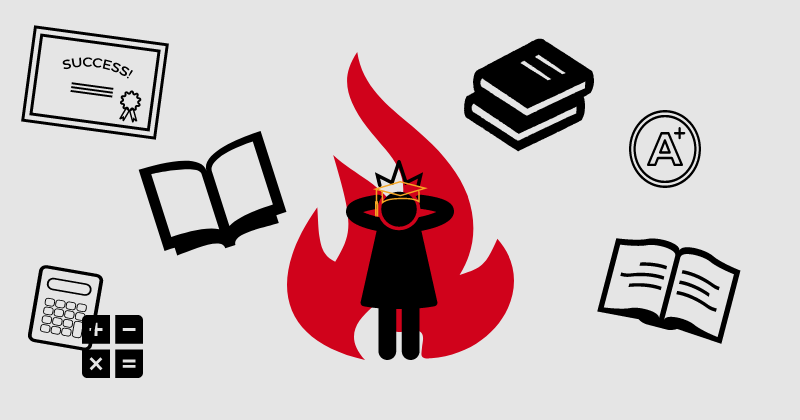Burnt out
Students are feeling the effects of being overworked
Students are feeling the effects of burnout leading to a mental health crisis among them.
April 27, 2022
As we near the end of the 2021-2022 school year, more and more students are starting to become unmotivated to finish out this academic year strong. They are becoming less inclined to complete their schoolwork, or rush through it so it is done and over with. This is called burnout, and it has become a plague amongst modern students.
Most will say burnout is an excuse for students to avoid their work and be lazy; however, this is not the case. It has become a serious problem with our generation and needs to be treated as one. When we don’t acknowledge the problem, we are causing it to become worse, which makes experience in high school more difficult than it needs to be. We need to face the reality, and unfortunately for students, that’s burnout.
Burnout happens when a student faces continuous frustration and stress with no time to relax. When students feel constantly stressed, this can lead to a variety of physical and mental problems, the most common being fatigue and insomnia. Other developments that could occur include an increased risk for anxiety, depression, larger mood swings (including becoming paranoid and hostile) and even headaches. All of these side effects of burnout can then lead to a decline in academic performance and losing interest in school activities.
It needs to be treated before it starts to become worse. This makes it sound like a disease and, in a way, it is as it is a disease within the mind. If not corrected, it can lead to devastating results for a person’s education.
From August 2020 to April 2021, student burnout rose from 40% of students showing signs of burnout to over 71%. In less than a year, burnout rates increased 31%. Of course, most of that increase came with the Coronavirus pandemic; however, those statistics have continued to remain true even after many states have integrated back into how things were before the outbreak.
At the beginning of COVID, most students found their online classes to be more manageable than their in-person ones. This was because of the flexibility built into those classes to help aid in the stress going on with the pandemic. Online classes still had their own dilemmas; however, when it comes to burnout, students found it easier to get their work done. After students started to show their faces in the classroom again, those stress levels started to increase. A year later, those levels are at an all-time high, even as the effects of the pandemic start to diminish.
A major reason for continuous burnout is the need to be in as many activities as they can. When most students join high school, they are introduced to a mass amount of clubs they did not have access to before. Students are taught that joining clubs will help them get into college and get better jobs in the future, which may be true; however, some students put too much emphasis on them. They are joining so many clubs that they are unable to keep up, and most stop attending altogether because it becomes too much for them to handle. Joining up just because it will look good on an application won’t do anything for you. Instead, join only two or three clubs that you truly enjoy. This will help prevent burnout and make your high school experience more enjoyable.
Some students even acquire leadership roles within their designated clubs. This forces even more responsibility onto them. For example, being in journalism and an editor at the same time has become a bit difficult. Not only do I have to keep up with my own stories, but I also have to edit others, creating more work for me. The obligations put onto students and the expectations given to them in these leadership positions can lead to even more burnout, resulting in a student possibly becoming less inclined to participate it the activity they once enjoyed. To avoid this, students should be sure that they are not only joining clubs that actually interest them, but if they wish to play more of a part in them by gaining a leadership role, that they have the time in the schedule, or that they make time for it.
Other than joining a mass amount of clubs to keep themselves occupied, busy work is also an area of concern when it comes to students and burnout. Any assignment that can be completed quickly and has no beneficial value to a lesson is considered busywork. It makes no sense for a teacher to send home an assignment that will not help a child process the information they have learned in class. The work is to only keep students occupied, while not being able to learn anything from it.
Teachers may consider the work they are assigning to their class as important; however, some students may disagree. Not every student will be pleased with the work provided, meaning they should prepare themselves for the work that will be given to them before they decide to join a particular class; however, teachers also don’t realize the work given out may not be beneficial to their students. For example, assigning a word search as class homework won’t teach a child vocabulary. Instead, it will take time out of that student’s day that could be used for other classes or other activities. Spending mass amounts of time on homework can lead to more stress which increases the chance that student becomes “burnt out.”
Rather than assigning work because they feel the need to, teachers should give out material that will help their students learn and process information from the assignments they are given. School districts should also learn to not force their teachers to provide a certain amount of work to their students. They should focus on how the work is going to help them, rather than making sure they have some form of homework when it is truly not needed.
Busy work has led to an emphasis on grades over learning which has led to a significant increase in burnout amongst students. Schools seem to value a grade on a piece of paper, rather than if the student is able to learn and process the material given to them. Grades should be used to show progress in one’s learning, but they should not be emphasized so much that a student believes they need to receive good grades on their assignments. This kind of thinking causes students to overwork themselves, which then leads to burnout. We, as students, need to learn to stop putting our grades onto pedestals and accept that not every assignment completed will be perfect. Once this thinking is accepted by educators and students alike, less stress will be put upon students to ensure their assignments are perfect, leading to less burnout which will increase the well-being of all students.
Students are not the only ones feeling the effects of being burnt out: teachers are as well. A survey sent out by the teachers union found that over two-thirds of respondents said that they felt more stressed compared to last year, and another 57% said that they were working much more as well. The major cause behind this is staff shortages. With teachers working more than they should, the effects of burnout among them start to increase. Burnout can affect teachers in the same way it does students with our educators becoming less and less enthusiastic with their job, which is no fun for them or the students they teach. To help burnout among students, something first needs to be done to help out teachers as well.
Burnout is a major problem and will not be going away any time soon. Something needs to be done to ensure that students in future generations will be able to enjoy their education, rather than being stressed for the entirety of their high school careers. Once burnout is properly acknowledged and dealt with, our education system will become more enjoyable and effective for future generations to enjoy.







